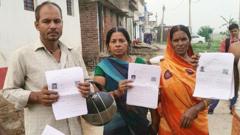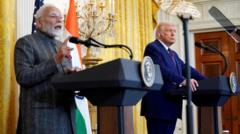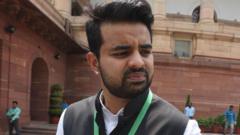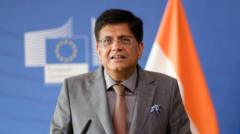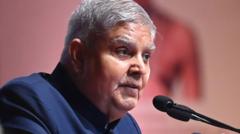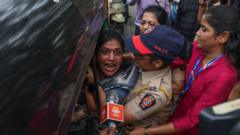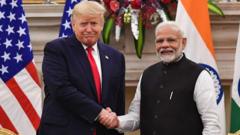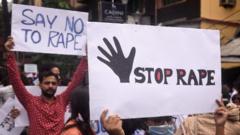In the race for Delhi's legislative assembly, the BJP's early leads suggest a possible comeback while the Aam Aadmi Party faces scrutiny amid corruption allegations.
Modi's BJP Takes the Lead in Competitive Delhi Election Race

Modi's BJP Takes the Lead in Competitive Delhi Election Race
As ballot counting continues in a tightly contested election, Prime Minister Modi's BJP shows early signs of leading in Delhi.
More than 60% of the 15 million registered voters cast their ballots on Wednesday in an election that observers describe as crucial not only for Delhi but also for the future political landscape of India. Early results from the Election Commission indicate the Bharatiya Janata Party (BJP) is leading in 41 of the 70 seats, whereas the Aam Aadmi Party (AAP), the incumbent since 2013, is ahead in 28 seats. While these results are promising for the BJP, the final tally could shift as more votes are counted.
Predictions from various exit polls supported the narrative of a BJP majority; however, political analysts caution against over-reliance on these surveys, highlighting a history of inaccuracies. The importance of winning Delhi extends beyond mere numbers—it holds significant symbolic power as the national capital. The AAP, recognized for its emphasis on welfare policies, has faced recent turbulence due to corruption allegations, which it strongly denies.
For the BJP, retaking Delhi is a strategic priority after nearly three decades of absence from power within the city, particularly following recent successes in neighboring states like Maharashtra and Chhattisgarh. The party amplified its campaign efforts, enlisting the presence of prominent figures including Modi and Home Minister Amit Shah.
Although Congress, the longstanding opposition party at the national level, continues to contest, its prospects appear grim, particularly after being ousted from power in Delhi due to corruption scandals that drove voters towards the AAP. As the vote counts progress, Delhi's unique governance model reveals a division of responsibilities between the state legislature and the federally appointed lieutenant governor, often resulting in friction when rival parties govern each tier.
Both the AAP and BJP campaigns primarily focused on welfare enhancements, such as improved public education and healthcare services, with the BJP seeking to attract middle-class voters through tax cuts introduced in the recent federal budget.
Should the BJP secure victory in this crucial election, analysts predict a renewed affirmation of Modi's standing with Indian voters, especially in light of the party's loss of an outright majority in the previous general election. Conversely, a defeat would represent a considerable setback for the AAP, which initially garnered praise for its governance.
In the backdrop of this political contest, former Chief Minister Arvind Kejriwal has faced severe challenges, including allegations of corruption linked to a controversial alcohol policy, from which he has maintained his innocence. The Supreme Court has imposed restrictions on his official duties, complicating the AAP's ability to govern effectively.
Despite significant focus on welfare, one prevailing issue—Delhi’s notorious air pollution—was conspicuously absent from election discussions, although the BJP has committed to reducing the city’s Air Quality Index by half by 2030.
As counting continues, the outcome of this election will likely shape the political narrative in Delhi and across India for years to come.
Predictions from various exit polls supported the narrative of a BJP majority; however, political analysts caution against over-reliance on these surveys, highlighting a history of inaccuracies. The importance of winning Delhi extends beyond mere numbers—it holds significant symbolic power as the national capital. The AAP, recognized for its emphasis on welfare policies, has faced recent turbulence due to corruption allegations, which it strongly denies.
For the BJP, retaking Delhi is a strategic priority after nearly three decades of absence from power within the city, particularly following recent successes in neighboring states like Maharashtra and Chhattisgarh. The party amplified its campaign efforts, enlisting the presence of prominent figures including Modi and Home Minister Amit Shah.
Although Congress, the longstanding opposition party at the national level, continues to contest, its prospects appear grim, particularly after being ousted from power in Delhi due to corruption scandals that drove voters towards the AAP. As the vote counts progress, Delhi's unique governance model reveals a division of responsibilities between the state legislature and the federally appointed lieutenant governor, often resulting in friction when rival parties govern each tier.
Both the AAP and BJP campaigns primarily focused on welfare enhancements, such as improved public education and healthcare services, with the BJP seeking to attract middle-class voters through tax cuts introduced in the recent federal budget.
Should the BJP secure victory in this crucial election, analysts predict a renewed affirmation of Modi's standing with Indian voters, especially in light of the party's loss of an outright majority in the previous general election. Conversely, a defeat would represent a considerable setback for the AAP, which initially garnered praise for its governance.
In the backdrop of this political contest, former Chief Minister Arvind Kejriwal has faced severe challenges, including allegations of corruption linked to a controversial alcohol policy, from which he has maintained his innocence. The Supreme Court has imposed restrictions on his official duties, complicating the AAP's ability to govern effectively.
Despite significant focus on welfare, one prevailing issue—Delhi’s notorious air pollution—was conspicuously absent from election discussions, although the BJP has committed to reducing the city’s Air Quality Index by half by 2030.
As counting continues, the outcome of this election will likely shape the political narrative in Delhi and across India for years to come.



